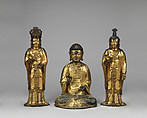Returned to lender The Met accepts temporary loans of art both for short-term exhibitions and for long-term display in its galleries.
Amitabha triad
Not on view
This triad represents the Buddha Amitabha (Korean: Amita), who presides over the Western Paradise, and his attendant bodhisattvas, Avalokiteshvara (Korean: Gwaneum), on the right, and Mahasthamaprapta (Korean: Deseji), on the left. By the fourteenth century, Buddhism had been the state religion on the Korean peninsula for nearly a thousand years. Amitabha has historically been a favored deity, given the easy promise of salvation and entry into his paradise, and was especially popular in the Goryeo period.
Inscriptions on the base of the two bodhisattvas provide the names of the patrons who commissioned this triad—Jang Hyeon and his wife—and of the project overseers, the monks Haeng-in, Yeongjeon, and Gyehwan. Following tradition, the statues were consecrated—that is, their hollow insides were filled with such materials as textiles and printed Buddhist texts. Also found inside was a dedication that records the date and names of the people, from the elites to the commoners, who participated in the production of the statues.
Due to rights restrictions, this image cannot be enlarged, viewed at full screen, or downloaded.
This artwork is meant to be viewed from right to left. Scroll left to view more.





